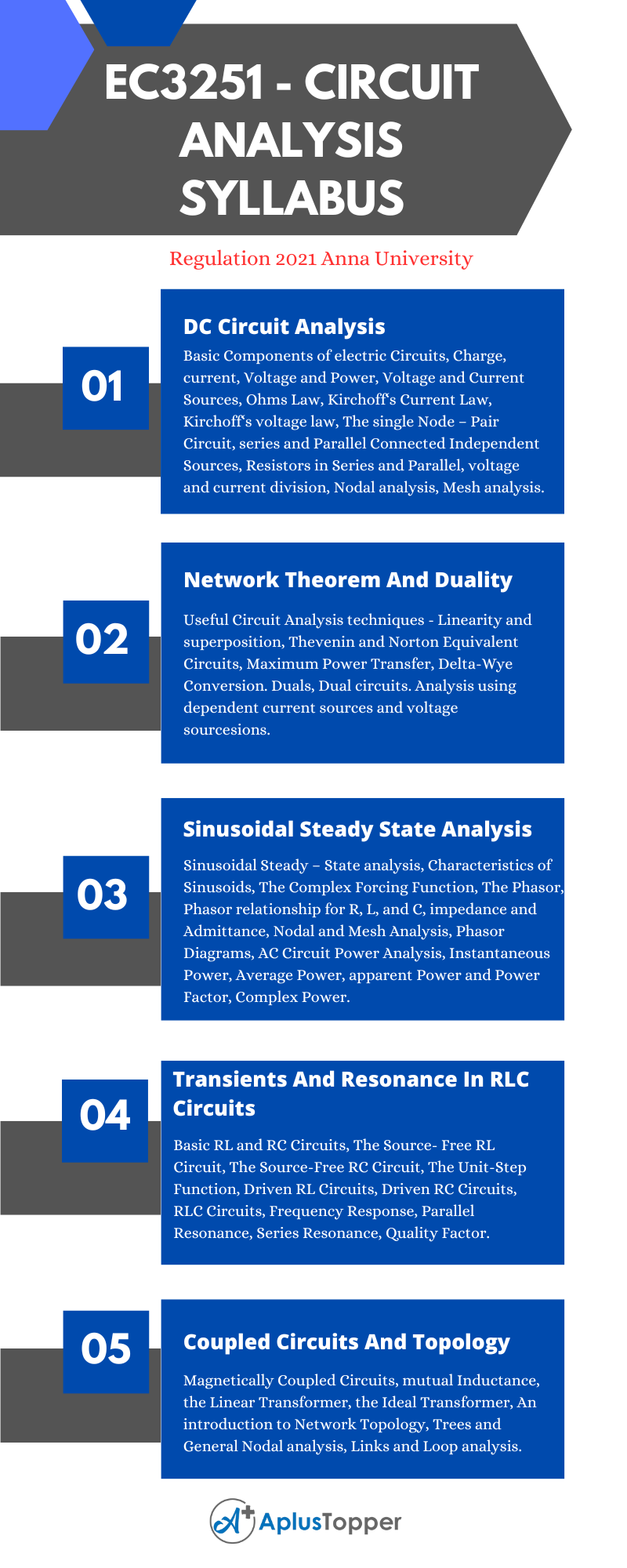Code EC3251 deals with the subject from the Anna University Regulation 2021, related to affiliated institutions, syllabus of B.E Electronics and Telecommunication Engineering. In this article, we discuss the Circuit Analysis Syllabus.
We intend to provide the syllabus of EC3251 – Circuit Analysis, we include the textbooks and references from the faculty of experts. You can get the required information unit-wise. The following links will help you to get proper information. I hope you can find the details in the article given below.
If you want to know more about the syllabus of B.E Computer Science and Engineering (Cyber security) Syllabus connected to an affiliated institution’s four-year undergraduate degree program. We provide you with a detailed Year-wise, semester-wise, and Subject-wise syllabus in the following link B.E Electronics and Telecommunication Engineering Syllabus Anna University, Regulation 2021.
Aim of Objectives:
- To learn the basic concepts and behaviour of DC and AC circuits.
- To understand various methods of circuit/network analysis using network theorems.
- To understand the transient and steady state response of the circuits subjected to DC excitations and AC with sinusoidal excitations.
- To learn the concept of coupling in circuits and topologies.
EC3251 – Circuit Analysis Syllabus
Unit I: DC Circuit Analysis
Basic Components of electric Circuits, Charge, current, Voltage and Power, Voltage and Current Sources, Ohms Law, Kirchoff‘s Current Law, Kirchoff‘s voltage law, The single Node – Pair Circuit, series and Parallel Connected Independent Sources, Resistors in Series and Parallel, voltage and current division, Nodal analysis, Mesh analysis.
Unit II: Network Theorem And Duality
Useful Circuit Analysis techniques – Linearity and superposition, Thevenin and Norton Equivalent Circuits, Maximum Power Transfer, Delta-Wye Conversion. Duals, Dual circuits. Analysis using dependent current sources and voltage sourcesions.
Unit III: Sinusoidal Steady State Analysis
Sinusoidal Steady – State analysis, Characteristics of Sinusoids, The Complex Forcing Function, The Phasor, Phasor relationship for R, L, and C, impedance and Admittance, Nodal and Mesh Analysis, Phasor Diagrams, AC Circuit Power Analysis, Instantaneous Power, Average Power, apparent Power and Power Factor, Complex Power.

Unit IV: Transients And Resonance In RLC Circuits
Basic RL and RC Circuits, The Source- Free RL Circuit, The Source-Free RC Circuit, The Unit-Step Function, Driven RL Circuits, Driven RC Circuits, RLC Circuits, Frequency Response, Parallel Resonance, Series Resonance, Quality Factor.
Unit V: Coupled Circuits And Topology
Magnetically Coupled Circuits, mutual Inductance, the Linear Transformer, the Ideal Transformer, An introduction to Network Topology, Trees and General Nodal analysis, Links and Loop analysis.
Text Books:
- Hayt Jack Kemmerly, Steven Durbin, “Engineering Circuit Analysis”, Mc Graw Hill education, 9th Edition, 2018.
- Charles K. Alexander & Mathew N.O.Sadiku, “Fundamentals of Electric Circuits”, Mc Graw Hill, 2nd Edition, 2003.
- Joseph Edminister and Mahmood Nahvi, ―Electric Circuits, Schaum‘s Outline Series, Tata McGraw Hill Publishing Company, New Delhi, Fifth Edition Reprint 2016.
References:
- Robert.L. Boylestead, “Introductory Circuit Analysis”, Pearson Education India, 12th Edition, 2014. David Bell, “Fundamentals of Electric Circuits”, Oxford University Press, 7th Edition, 2009.
- John O Mallay, Schaum’s Outlines “Basic Circuit Analysis”, The Mc Graw Hill companies, 2nd Edition, 2011.
- Allan H. Robbins, Wilhelm C. Miller, ―Circuit Analysis Theory and Practice, Cengage Learning, Fifth Edition, 1st Indian Reprint 2013.
Related Posts on Semester – II:
- HS3252 Professional English – II
- MA3251 Statistics and Numerical Methods
- PH3254 Physics for Electronics Engineering
- BE3254 Electrical and Instrumentation Engineering
- GE3251 Engineering Graphics
- GE3252 தமிரு் ததொழி்நு்பமு் /Tamils and Technology
